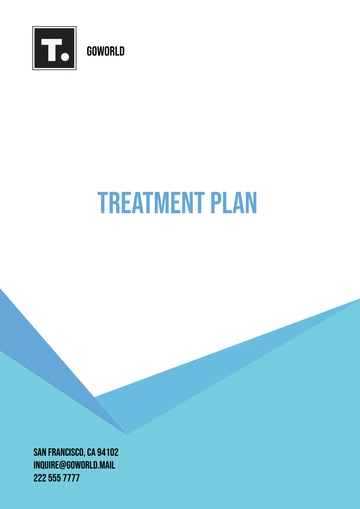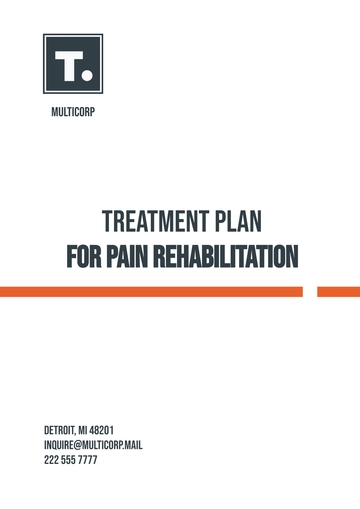Free Case Management Treatment Plan

Prepared By: [Your Name]
I. Case Overview
John is a 45-year-old office worker who has been experiencing chronic lower back pain for the past five years. Despite trying various treatments and therapies, including medications and physical therapy, his pain persists and significantly affects his daily life.
John reports difficulty sitting for prolonged periods at work, disrupted sleep due to pain, and limited participation in recreational activities with his family. His goal is to find effective pain management strategies that will allow him to regain function, improve his quality of life, and resume activities that bring him joy.
II. Assessment
During the initial assessment phase, the client's medical history, pain symptoms, and functional limitations are thoroughly evaluated. A detailed intake interview is conducted to gain insight into the onset, duration, and nature of the client's pain, as well as its impact on daily activities, work, sleep, and mood.
Psychosocial factors such as emotional distress, stressors, coping mechanisms, and social support are also explored to better understand the client's pain experience and potential contributing factors. Pain assessment tools such as the Visual Analog Scale (VAS) or McGill Pain Questionnaire may be utilized to quantify pain intensity and characteristics.
III. Treatment Plan Objectives
Pain Reduction: Alleviate pain intensity and frequency to improve the client's comfort and functional ability.
Functional Restoration: Enhance mobility, flexibility, and strength to optimize physical function and independence.
Psychological Support: Address emotional distress, stress, and anxiety related to chronic pain through supportive interventions and coping strategies.
Holistic Wellness: Promote overall well-being by addressing lifestyle factors such as nutrition, sleep hygiene, stress management, and social engagement.
IV. Treatment Interventions
Treatment Interventions | Description |
|---|---|
Multimodal Pain Management | Implement a comprehensive approach combining various modalities such as massage therapy, physical therapy, acupuncture, and cognitive-behavioral therapy (CBT). |
Massage Therapy | Utilize a combination of massage techniques such as Swedish massage, deep tissue massage, myofascial release, and trigger point therapy to address muscular tension, reduce pain, and promote relaxation. |
Physical Therapy | Develop a customized exercise program focusing on therapeutic exercises, stretching, and functional movements to improve strength, flexibility, and range of motion. |
Psychological Support | Offer counseling, psychoeducation, and mindfulness-based interventions to help the client cope with pain-related stress, anxiety, and depression. |
Lifestyle Modifications | Provide guidance on ergonomic principles, body mechanics, and posture awareness to prevent exacerbation of pain and promote musculoskeletal health |
V. Monitoring and Follow-Up
Regular reassessment of the client's pain levels, functional status, and treatment outcomes is conducted at predetermined intervals to evaluate the response to interventions and identify areas for adjustment or modification. Open communication between the client and the interdisciplinary healthcare team is encouraged to facilitate collaboration, share insights, and address any concerns or barriers encountered during the course of treatment.
The client is also empowered to actively participate in their care by providing feedback on their pain experience, treatment preferences, and goals for recovery. Based on the ongoing assessment and feedback, the treatment plan is adapted as needed to optimize outcomes and promote the client's overall well-being. Furthermore, follow-up appointments are scheduled to review progress, reinforce education, and provide ongoing support and guidance to the client as they navigate their journey towards chronic pain management and improved quality of life.
VI. Conclusion
In conclusion, John's case highlights the complex and multifaceted nature of chronic pain management. Through a comprehensive assessment process and tailored treatment plan, we aim to address the physical, psychological, and social aspects of John's pain experience. By incorporating a combination of modalities such as massage therapy, physical therapy, psychological support, and lifestyle modifications, we strive to alleviate John's pain, improve his functional ability, and enhance his overall well-being.
With ongoing monitoring, follow-up, and collaboration between John, the healthcare team, and other stakeholders, we are committed to supporting John on his journey towards effective chronic pain management and improved quality of life.
- 100% Customizable, free editor
- Access 1 Million+ Templates, photo’s & graphics
- Download or share as a template
- Click and replace photos, graphics, text, backgrounds
- Resize, crop, AI write & more
- Access advanced editor
Optimize your case management with the Case Management Treatment Plan Template offered by Template.net. This fully customizable, downloadable template is designed to assist in organizing and documenting client care. Editable in our AI Editor Tool, it provides flexibility to adapt plans as needed. Print your comprehensive, tailored treatment plans to ensure systematic and effective case management, improving outcomes and client satisfaction.
You may also like
- Finance Plan
- Construction Plan
- Sales Plan
- Development Plan
- Career Plan
- Budget Plan
- HR Plan
- Education Plan
- Transition Plan
- Work Plan
- Training Plan
- Communication Plan
- Operation Plan
- Health And Safety Plan
- Strategy Plan
- Professional Development Plan
- Advertising Plan
- Risk Management Plan
- Restaurant Plan
- School Plan
- Nursing Home Patient Care Plan
- Nursing Care Plan
- Plan Event
- Startup Plan
- Social Media Plan
- Staffing Plan
- Annual Plan
- Content Plan
- Payment Plan
- Implementation Plan
- Hotel Plan
- Workout Plan
- Accounting Plan
- Campaign Plan
- Essay Plan
- 30 60 90 Day Plan
- Research Plan
- Recruitment Plan
- 90 Day Plan
- Quarterly Plan
- Emergency Plan
- 5 Year Plan
- Gym Plan
- Personal Plan
- IT and Software Plan
- Treatment Plan
- Real Estate Plan
- Law Firm Plan
- Healthcare Plan
- Improvement Plan
- Media Plan
- 5 Year Business Plan
- Learning Plan
- Marketing Campaign Plan
- Travel Agency Plan
- Cleaning Services Plan
- Interior Design Plan
- Performance Plan
- PR Plan
- Birth Plan
- Life Plan
- SEO Plan
- Disaster Recovery Plan
- Continuity Plan
- Launch Plan
- Legal Plan
- Behavior Plan
- Performance Improvement Plan
- Salon Plan
- Security Plan
- Security Management Plan
- Employee Development Plan
- Quality Plan
- Service Improvement Plan
- Growth Plan
- Incident Response Plan
- Basketball Plan
- Emergency Action Plan
- Product Launch Plan
- Spa Plan
- Employee Training Plan
- Data Analysis Plan
- Employee Action Plan
- Territory Plan
- Audit Plan
- Classroom Plan
- Activity Plan
- Parenting Plan
- Care Plan
- Project Execution Plan
- Exercise Plan
- Internship Plan
- Software Development Plan
- Continuous Improvement Plan
- Leave Plan
- 90 Day Sales Plan
- Advertising Agency Plan
- Employee Transition Plan
- Smart Action Plan
- Workplace Safety Plan
- Behavior Change Plan
- Contingency Plan
- Continuity of Operations Plan
- Health Plan
- Quality Control Plan
- Self Plan
- Sports Development Plan
- Change Management Plan
- Ecommerce Plan
- Personal Financial Plan
- Process Improvement Plan
- 30-60-90 Day Sales Plan
- Crisis Management Plan
- Engagement Plan
- Execution Plan
- Pandemic Plan
- Quality Assurance Plan
- Service Continuity Plan
- Agile Project Plan
- Fundraising Plan
- Job Transition Plan
- Asset Maintenance Plan
- Maintenance Plan
- Software Test Plan
- Staff Training and Development Plan
- 3 Year Plan
- Brand Activation Plan
- Release Plan
- Resource Plan
- Risk Mitigation Plan
- Teacher Plan
- 30 60 90 Day Plan for New Manager
- Food Safety Plan
- Food Truck Plan
- Hiring Plan
- Quality Management Plan
- Wellness Plan
- Behavior Intervention Plan
- Bonus Plan
- Investment Plan
- Maternity Leave Plan
- Pandemic Response Plan
- Succession Planning
- Coaching Plan
- Configuration Management Plan
- Remote Work Plan
- Self Care Plan
- Teaching Plan
- 100-Day Plan
- HACCP Plan
- Student Plan
- Sustainability Plan
- 30 60 90 Day Plan for Interview
- Access Plan
- Site Specific Safety Plan





























